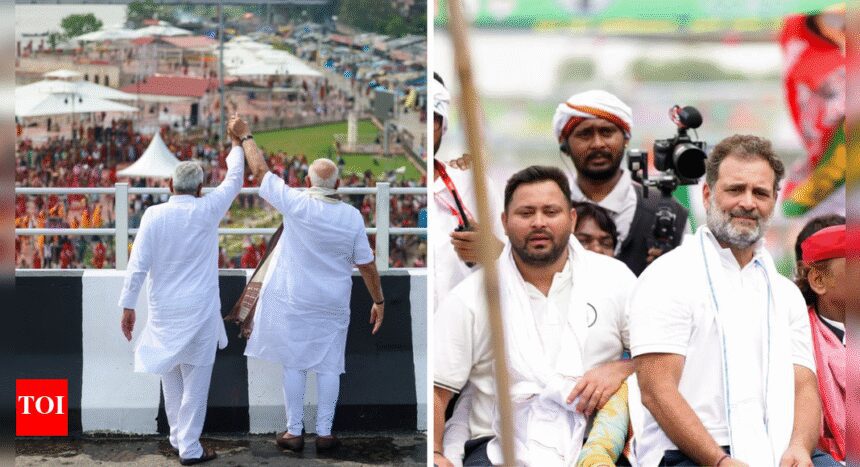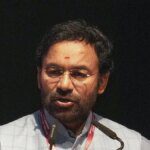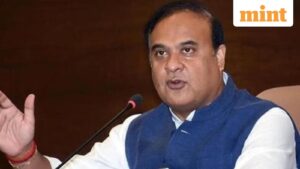NEW DELHI: The Election Commission announced the upcoming assembly elections in Bihar, referring to it as the “mother of elections.” Chief Election Commissioner Gyanesh Kumar revealed that the elections will occur in two phases, on November 6 and 11, with results scheduled for November 14.
As the elections approach, the political landscape has become clearly defined. The National Democratic Alliance (NDA), comprising the Bharatiya Janata Party (BJP), Janata Dal (United) (JD(U)), and Lok Janshakti Party (Ram Vilas) (LJP), is set to face a united opposition led by Tejashwi Yadav of the Rashtriya Janata Dal (RJD), receiving support from the Congress and Left parties. Additionally, new entrant Prashant Kishor’s Jan Suraaj is contesting all 243 seats in the state.
Mahagathbandhan Strategies
The Mahagathbandhan, with Tejashwi Yadav as its Chief Ministerial candidate, aims to capitalize on the “Vote Chori” issue and alleged irregularities in the revision of electoral rolls before the elections. The Congress, allied with the RJD, initiated the “Voter Adhikar Yatra,” where Rahul Gandhi and Tejashwi Yadav traveled across Bihar, accusing the Election Commission of facilitating BJP’s electoral manipulation. Subsequently, Tejashwi launched his own “Bihar Adhikar Yatra” targeting the Nitish Kumar-led NDA government regarding unemployment and crime rates.
Despite Tejashwi’s popularity, internal challenges persist. The Congress party’s vote percentage has steadily declined since its ousting from power in 1990, and concerns over its state cadre’s effectiveness are being raised. Furthermore, legal issues involving Lalu Yadav’s family, including the ongoing land-for-jobs scam investigation by the Enforcement Directorate (ED), add pressure. Although Tejashwi commands a loyal Muslim-Yadav vote base, which constitutes nearly 30% of the electorate, internal family dynamics have divided his focus.
The Mahagathbandhan partners are still negotiating seat-sharing arrangements, complicating consensus-building prior to the elections. In 2020, RJD contested 144 seats, winning 75, while Congress contested 70 and secured 19 seats. The Left parties, including CPI-ML, CPM, and CPI, performed strongly as well.
This election, new parties such as the Vikasheel Insaan Party (VIP), Janmukti Party (JMM), and a breakaway faction of LJP have joined the opposition alliance. The VIP, which previously exited the alliance to join the NDA, is now demanding 60 seats and the position of deputy chief minister in the event of an alliance victory.
NDA’s Campaign Approach
Bihar Chief Minister Nitish Kumar’s JD(U) and the BJP seek to retain power and increase their seat margins in the upcoming elections, emphasizing development and the strength of a “double-engine government”—PM Narendra Modi at the Centre with Kumar in Bihar. Nitish Kumar, known for his governance model, has implemented various popular welfare schemes, including enhanced pensions and financial assistance to women.
The NDA benefits from a strong organizational structure, supported by RSS-affiliated groups. Nitish Kumar, belonging to the Kurmi caste, has aligned himself with the Extremely Backward Classes, the largest demographic in Bihar. However, critics suggest that his declining health might impact his political prospects, and internal competition between JD(U) and BJP is evident.
In the 2020 elections, BJP emerged as the second-largest party with 74 seats, while JD(U) won 43 seats.
Jan Suraaj Initiative
Prashant Kishor, known for his role as a poll strategist, has positioned the Jan Suraaj Party as a contender against the established alliances. Kishor’s campaign focuses on governance issues while avoiding caste-based politics, announcing intentions to contest all 243 seats. His previous experience and critiques aimed at NDA leadership have gained him attention, challenging prominent officials such as Deputy Chief Minister Samrat Choudhary and BJP MP Sanjay Jaiswal.
Notably, Kishor, previously accused of aiding BJP, has broadened his criticism to include members of both the NDA and Mahagathbandhan, maintaining substantial engagement with the electorate and ensuring unpredictability in his campaign approach.










